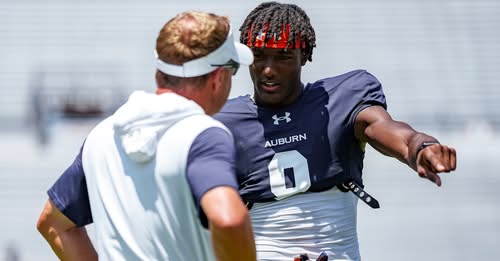**During the spring football period, Auburn’s wide receivers coach Marcus Davis was unsure who would emerge as the leader in the position group. The Tigers had lost key contributors from the previous season, leaving a void that needed to be filled by a mix of experienced players and promising newcomers. As the team progressed through spring practices, summer workouts, and into fall camp, the competition intensified, with several players stepping up to claim larger roles. The wide receiver room, once a question mark, began to take shape, showcasing depth, talent, and potential playmakers capable of elevating Auburn’s passing attack in the upcoming season.**
The departure of veteran receivers from the previous roster left Marcus Davis with the challenge of rebuilding the unit. With no clear-cut No. 1 option, the spring session became an open audition. Players like Ja’Varrius Johnson, a speedy slot receiver with big-play ability, and Malcolm Johnson Jr., a transfer from Maryland, brought experience but had yet to establish themselves as consistent go-to targets. Meanwhile, younger players such as Camden Brown, a physically imposing outside receiver, and Jay Fair, a shifty route-runner, showed flashes but needed refinement. The lack of a defined hierarchy meant every practice rep was crucial, and Davis emphasized competition to bring out the best in his group.
One of the most intriguing developments was the emergence of redshirt freshman Omari Kelly. A former high school quarterback who transitioned to wide receiver, Kelly possessed a unique combination of size, athleticism, and football IQ. Throughout spring ball, he began turning heads with his ability to high-point catches and create separation. His progress was a bright spot, but Davis remained cautious, knowing that translating practice success to game performance was the next step. Similarly, sophomore Camden Brown, standing at 6’3”, offered a physical presence on the outside, but consistency in route-running and hands remained areas for improvement.
The summer months were critical for player development. Strength and conditioning sessions, coupled with player-led workouts, helped build chemistry between the receivers and quarterbacks. Payton Thorne, a transfer from Michigan State expected to take over as the starting quarterback, spent extra time working with the receivers to develop timing and trust. This period was especially important for the younger players, as understanding the nuances of the offense and building rapport with the QB would determine their playing time.
As fall camp arrived, the competition grew even fiercer. Coaches began evaluating not just physical ability but also mental toughness, consistency, and reliability in high-pressure situations. Marcus Davis stressed the importance of mastering the playbook, noting that the best receivers were not just athletes but also students of the game. The Tigers’ offense, under new coordinator Philip Montgomery, required precise route-running and the ability to adjust on the fly, putting additional pressure on the receivers to perform at a high level.
By the end of camp, a few names began separating themselves. Ja’Varrius Johnson, with his explosive speed, became a favorite target on deep routes and quick slants. His experience in the system gave him an edge, and his ability to make defenders miss in open space made him a threat after the catch. Malcolm Johnson Jr., another veteran, showcased his versatility by lining up both outside and in the slot, using his polished route-running to create separation. Meanwhile, Omari Kelly’s continued development made him a potential breakout candidate, with coaches praising his work ethic and natural ball skills.
The true test, however, would come in live game action. Auburn’s season opener would reveal whether the progress made in practice could translate to Saturdays. Early matchups against Power Five opponents would quickly expose any weaknesses, but they would also provide opportunities for new stars to emerge. Marcus Davis remained optimistic, emphasizing that the group’s depth—rather than relying on one dominant receiver—could be its strength. A committee approach, with different players stepping up in different situations, might be the formula for success.
Beyond the established names, a few under-the-radar players also pushed for playing time. Freshman speedster Daquayvious Sorey, an early enrollee, displayed raw talent that could earn him situational snaps. Walk-ons and special teams contributors also made their case, proving that the competition extended beyond the scholarship players. Davis made it clear that roles would be earned, not given, and that performance in games would dictate snap counts.
As the season approached, the narrative around Auburn’s receivers shifted from uncertainty to cautious optimism. While the group lacked a proven superstar, the collective talent and competitive fire suggested that the Tigers could field a productive passing attack. The development of the unit would be crucial in determining Auburn’s offensive success, particularly in a conference known for elite defenses. If the receivers could consistently win one-on-one matchups and provide reliable targets for the quarterback, the Tigers could exceed expectations.
For Marcus Davis, the journey from spring uncertainty to fall readiness was a testament to the players’ dedication. The wide receiver room had transformed into a competitive, hungry group eager to prove itself. The leader he had once searched for might not have been a single individual but rather a collective effort—a unit determined to silence doubts and make an impact when it mattered most.
As the season unfolds, all eyes will be on how this group performs under pressure. Will a true No. 1 receiver emerge, or will Auburn rely on a balanced approach? The answer will shape the Tigers’ offensive identity and determine whether the passing game can keep defenses honest. One thing is certain: the competition that began in spring has forged a deeper, more resilient group—one ready to make its mark on the field.



